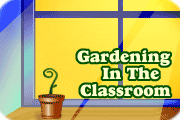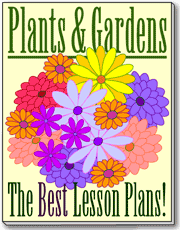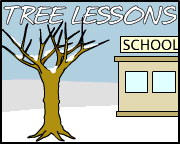| Volume 4, Issue 9
May 9, 2006
Plants
WELCOME! to Education World's Early Childhood Newsletter. Every other week, I'll share some
ideas on a familiar teaching theme. Hopefully you will find a new activity idea or two -- or a new
twist on one of your old favorites! Since I know you are very busy, I'll be short and sweet -- like
most of activities I suggest.
Tell a friend about us! Invite them to sign up for their own FREE subscription at /newsletter_form
 At
Circle Time, invite children to take part in this finger play as they recite the rhyme. At
Circle Time, invite children to take part in this finger play as they recite the rhyme.
Little Sammy Seed
Hey there little Sammy Seed,
Resting in the ground. (Palms together, rest head on hands)
Will you grow into a plant,
That spreads its joy around? (Turn around w/ arms out)
Sun and rain, and rain and sun (Arms up for sun; arms down moving fingers for rain)
Help you grow up strong. (Stand tall and straight)
Then come your pretty flowers (Hand up above eyes, looking)
To last all summer long!
 TIME
FOR FLOWERS TIME
FOR FLOWERS
Gather an assortment (sizes and colors) of muffin tin liners. Give each child a Popsicle stick and
help him or her paint it green. When the sticks are dry, help children add a drop of glue to the
top of each stick. Next invite children to choose a large a muffin liner and press it onto the glue
drop. When that is dry, children can add another drop of glue to the center of the large muffin
liner and press a smaller liner onto that drop. Finally let children glue green leaf shapes onto
their Popsicle sticks to complete their flowers.
GROWING CARROTS
Create for each student an 8-page, carrot-shaped journal. Give each child a journal. Then give each
child a real carrot. Help students put their names on the covers of their journals and draw pictures
of their carrots on the first page of their journals. Next, cut off the top of each carrot and let
students draw the tops of their carrots on the second page of their journals. Instruct each child
to place some pebbles into a small shallow dish. Then students should place their carrot tops in
the dish and add enough water to cover the bottom of the carrot. Ask students to draw a picture
of the carrot top in the dish on the third journal page. Put the dishes in sunlight. Invite students
to observe their carrots and draw journal pictures of their growth each day. Carrot tops should
sprout after 3 to 5 days. Later, encourage students to share their journals and talk about their
observations.
READ IT AND EAT IT
Read to students The Carrot Seed, by Ruth Kraus. Have children use carrot tops and tempera
paint to stamp colorful pictures. Then serve carrot cake and carrot juice for a snack.
SEED IT!
--- Gather seeds from all kinds of plants: poppies, acorns, lettuce, watermelon, and so on. Do an
estimating activity by asking children to decide which kinds will fill a cup more. Then add each
kind to a cup to let children check their predictions.
--- Have a discussion of what a seed needs in order to grow. Plant a bean seed in a plastic cup
with wet paper towels. Place some seeds in sunny windowsill and others in a closet. Ask: Which seeds
will grow best? Check the seeds periodically and discuss results.
--- Help children estimate how long it will take the seeds to germinate. Use a simple chart to note
the growth of the seedlings once they sprout.
--- Say to children, "You just found a huge purple seed. You plant it in your yard and it grows
into a ______________." Encourage children to complete the sentence and record their results.
Read the results aloud to the group.
--- Create task cards and laminate them. Let each one show a step in the growth of a seed. Place
them on a table for children to correctly sequence.
LET'S EAT DIRT!
Make 3 boxes of chocolate pudding. Mix part of the pudding with some non-dairy topping to obtain
a "muddy" shade of brown. Crumble up some chocolate crème sandwich cookies and
layer in a small plastic cup: the darker pudding mud, some crushed cookie, and the lighter pudding
mud. Top with a few gummy worms and serve. Kids love eating dirt!
GET TO KNOW ROOTS
Discuss with children the function of a plant's roots. Help them understand that roots carry water
and nutrients from the soil to the plant. Next give children straws and small drinking cups with
a bit of water in each one. As children "suck up" the water, explain that plants' roots
act in much the same way. Further illustrate the concept by placing a stalk of celery in a glass
water colored with food coloring. Invite children to observe for a few days and note what takes
place.
 Check
out the following Web sites for additional background and activities. Check
out the following Web sites for additional background and activities.
What's It Like Where You Live?
Click on any biome to find out about the plants that grow there. There's lots of other information
too.
http://www.mbgnet.net/
The Biology of Plants
Great information and colorful photos showing seeds, parts of a plant, how a plant grows, and more.
http://www.mbgnet.net/bioplants/main.html
Little Brown
Seeds
Use this little poem with your children to teach about a seed's growth.
http://www.theteacherscorner.net/thematicunits/brown.htm
Welcome to Kidsgardening
A terrific resource from the National Gardening Association! Provides classroom activities, news
about ongoing kids' programs, and more -- all about plants and gardening.
http://www.kidsgardening.com/
National Arbor Day Foundation
The ultimate resource for teaching kids about some of the world's most magnificent plants –
trees.
http://www.arborday.org/kids/
|